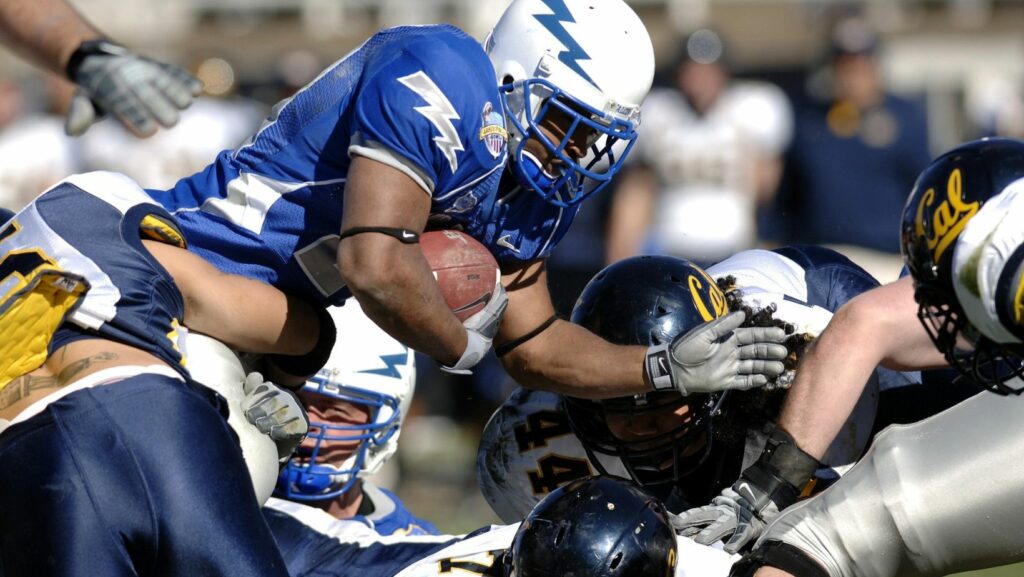Fourth down, goal line, 12 seconds left. Your offense needs one play to win the championship. The crowd noise makes verbal communication impossible. Hand signals are too slow. Your quarterback looks toward the sideline, waiting for the play that will determine your season.
This moment reveals why modern football demands better communication methods than traditional systems can provide. Games are decided by split-second timing and perfect execution. Teams that communicate faster and more accurately gain decisive advantages over those relying on outdated methods.
The difference between winning and losing often comes down to which team can execute their strategy without communication failures disrupting critical plays.
Why Traditional Play Calling Breaks Down
Football began as a simple game with basic offensive and defensive concepts. Coaches could communicate effectively using hand signals and verbal commands because players only needed to understand a few dozen plays.
Modern football operates with hundreds of play variations, multiple formations, and complex pre-snap adjustments. Traditional communication methods cannot handle this complexity reliably.
Hand signals work during quiet practice sessions but fail when 80,000 screaming fans create noise levels that make hearing impossible. Weather conditions like rain, snow, or bright sunlight eliminate the visibility needed for visual signals.
Sign stealing has become sophisticated. High school teams now employ the same video analysis techniques that professional scouts use. Your elaborate signal system becomes your opponent’s advantage when they decode your calls before your players receive them.
Practice time disappears when coaches must spend hours teaching players to recognize complex signal combinations instead of focusing on skill development and strategy execution.
Digital Communication Eliminates These Problems
A football play calling system functions like a direct communication channel between coaches and players. Coaches select plays on handheld devices or tablets. Players receive instructions instantly on wearable displays worn on their wrists or arms.
The technology uses encrypted wireless signals that prevent interception. Communication happens in seconds rather than minutes, regardless of crowd noise, weather conditions, or field position.
Modern systems provide two-way confirmation. Coaches know when players have received and acknowledged their assignments, eliminating uncertainty about whether the right play was communicated successfully.
Tactical Advantages During Games
Digital play calling creates specific tactical advantages that traditional methods cannot match:
Faster Tempo Control No-huddle offenses become truly fast when players receive plays instantly. Teams can snap the ball 8-10 seconds after the previous play ends instead of the 15-20 seconds required for traditional communication.
This speed prevents defenses from making personnel substitutions or complex adjustments. Offensive coordinators can call plays based on defensive alignment without giving opponents time to counter-adjust.
Multi-Personnel Flexibility Complex offensive packages require different players to enter the game for specific plays. Digital systems allow coaches to communicate simultaneously with multiple position groups.
Receivers get route information while linemen receive blocking assignments and backs learn their responsibilities. This parallel communication enables more sophisticated play designs without increasing execution time.
Pre-Snap Adjustments Quarterbacks can receive audible options and hot routes through their devices after seeing defensive alignments. Instead of limited verbal audibles that defenses might recognize, digital systems provide unlimited adjustment possibilities.
Coaches can send new plays if they observe defensive changes during pre-snap alignment. This capability turns every play call into a dynamic decision rather than a static choice made in advance.
Defensive Applications
Defensive coordinators gain equal advantages from digital communication systems:
Coverage Adjustments Defensive backs receive specific coverage assignments based on offensive formation and down-and-distance situations. Coaches can call different coverages for slot receivers versus outside receivers without complex verbal signals.
Blitz Packages Linebackers and defensive backs get blitz assignments that change based on offensive protection schemes. Coaches can send different pass rushers on every play without tipping their intentions through predictable signal patterns.
Run Fits Each defender receives specific gap responsibilities that adjust based on offensive formation. This precision prevents the confusion that leads to big running plays when players are uncertain about their assignments.

Special Teams Coordination
Special teams units present unique communication challenges because players must execute precise timing while spread across the entire field. Digital systems solve several critical problems:
Return Coverage Coverage teams receive specific lane assignments and contain responsibilities based on return formation. Coaches can adjust coverage patterns without gathering players for huddle discussions that waste valuable time.
Punt Protection Protection schemes change based on defensive rush patterns that coaches identify from the press box. Digital communication allows real-time adjustments to protection calls without visible signals that tip off the rush.
Field Goal Operations Holders and snappers receive timing information and fake play options through their devices. This communication remains private from defensive players who might try to read traditional signals.
Practice Efficiency Benefits
Digital systems multiply practice productivity by eliminating communication delays:
Scout Team Efficiency Scout teams can run 60-80 plays per practice period instead of the 25-35 possible with traditional methods. Players receive plays instantly and execute immediately without waiting for coaches to explain assignments.
Situational Drilling Teams can practice specific game situations more frequently because setup time disappears. Third-and-long, red zone, and two-minute drill scenarios get more repetitions when communication doesn’t slow transitions between plays.
Installation Speed New plays and formations can be installed during practice without stopping to teach signal recognition. Players learn assignments through clear text instructions rather than memorizing complex signal combinations.
Competitive Intelligence Protection
Modern football coaching involves significant intellectual property that teams must protect from opponents:
Signal Security Encrypted digital communication prevents the sign stealing that has affected programs at every level. Teams can use their full playbook without worrying about giving strategic advantages to future opponents.
Play Call History Digital systems maintain logs of which plays were called in specific situations. This information helps coaches analyze their own tendencies and make adjustments that surprise opponents who scout their patterns.
Formation Flexibility Teams can use multiple formations and personnel packages without opponents being able to predict play types based on visual cues. Digital communication separates formation from play selection in ways that traditional methods cannot.
Player Development Advantages
Digital communication systems accelerate player development in measurable ways:
Learning Curve Reduction New players can contribute immediately because they don’t need to master complex signal recognition before playing. Freshmen and transfers can focus on football skills rather than communication protocols.
Error Reduction Clear, specific instructions prevent the mental errors that result from signal misinterpretation. Players execute assignments more accurately when they receive unambiguous directions.
Confidence Building Players perform better when they’re certain about their assignments. Digital communication eliminates doubt and hesitation that comes from unclear or missed signals.
Implementation Strategies
Successful adoption requires careful planning and gradual introduction:
Training Phases Start with simple plays during non-contact periods. Progress to complex situational work as players become comfortable with the technology. Full implementation typically takes 3-4 weeks of regular practice.
Backup Systems Maintain traditional signal capabilities during the transition period. Technical problems shouldn’t prevent teams from communicating effectively during critical moments.
Staff Coordination All coaches must understand the system to provide consistent communication. Mixed methods create confusion that negates the benefits of digital advancement.
The Competitive Reality
Football programs that adopt digital communication gain measurable advantages over those using traditional methods. These advantages compound over time as teams develop more sophisticated strategies enabled by reliable communication.
The question facing coaches isn’t whether digital systems are better than traditional methods. The question is whether your program will gain early advantages by adopting superior communication technology or fall behind competitors who make this transition first.
Every snap matters in close games. Every practice repetition contributes to season success. Every strategic advantage influences outcomes when talent levels are similar.
Teams that communicate better execute better. Teams that execute better win more games. Teams that win more games attract better players and coaches, creating cycles of success that become difficult for competitors to break.
Championship teams share one common characteristic: they execute their strategy better than their opponents execute theirs. Digital communication systems provide the foundation for this execution by ensuring every player knows exactly what to do on every play, regardless of external conditions or opponent tactics.

